Recreation Center Business Plan
This document provides information about Play Time for Kids, including business structure, company goals, projected growth, venture capital requirements, start-up costs, investment analysis, and industry trends.
Play Time for Kids focuses on the family entertainment industry and aims to develop one or more family entertainment centers (FEC) in the Our County, Big City area.
With a focus on family entertainment in a family-oriented community, Play Time for Kids is positioned to capitalize on the expanding and profitable industry.
Entertainment has become a buzzword in the new millennium. According to David L. Malmuth, senior vice president of TrizenHahn Development Corp., people want an authentic, fun, and participatory experience. In the United States, spending on entertainment surpasses spending on health care and clothing.
Quality family entertainment is the core of Play Time for Kids. The company plans to construct and commercialize one FEC in the initial development phase, catering to the demands of the current market.
In addition to other funding and capitalization efforts, the company plans to seek funds from other sources for purchasing the initial building lease.
According to the U.S. Census Bureau, from 1999 to 2000, personal consumption and expenditures for amusement and recreation increased by $31.5 billion, with a gross industry revenue of $56.2 billion.
With a strong management team and an aggressive marketing plan, we project a consistent minimum annual growth of five percent.
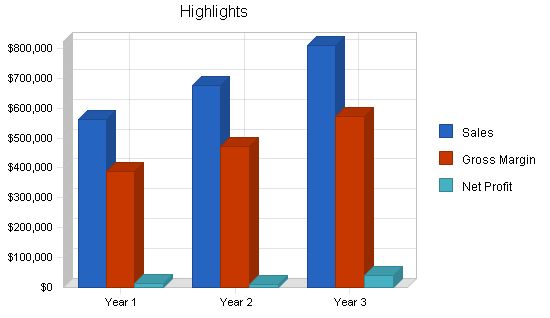
1.1 Objectives:
– Create a service-based company that exceeds customers’ expectations.
– Increase the number of customers by at least 20% per year through superior customer service and word-of-mouth referrals.
– Achieve a clientele return rate of 90% by the end of the first year.
– Become an established community destination by the end of the first year.
– Educate the community on the company’s offerings.
– Become the industry leader in Northeast Our County.
1.2 Mission:
– Provide excellent child play care in a kid-friendly atmosphere, ensuring excellent service for both parents and children in a playful, educational, and safe environment.
1.3 Keys to Success:
– Superior Customer Service: Provide high-quality hourly care and service.
– Environment: Offer a clean, upscale, enjoyable environment conducive to providing professional, trusting service.
– Convenience: Provide a wide range of services in one location.
– Location: Offer an easily accessible facility for customer convenience.
– Reputation: Establish credibility, integrity, and 100% dedication.
– Indoor activities for year-round entertainment.
– Facility designed to prevent overcrowding.
– Seasoned management team.
The company believes that certain risk factors can be minimized by:
– Initial capitalization to sustain operations through the first year.
– Low overhead through the use of multi-skilled employees and continual training.
– Strong customer base through aggressive marketing.
– Strong community ties and involvement with nonprofit organizations.
Current Family Entertainment Centers (FECs) primarily emphasize hands-on discovery learning through free spontaneous play. These centers can also incorporate elements of pure entertainment. However, most adults do not fully understand and appreciate the value of spontaneous play for their children’s social, physical, mental, and emotional development. Therefore, these new types of children’s centers in the U.S. are marketed as children’s discovery or edutainment centers. Play Time for Kids is a new company that will provide high-level Play Care, Edutainment, and Customer Service in the following categories:
– Play care
– Educational play
– Children’s activities
– Birthday parties
– Special events
– Staffing with a personal touch
– Photography services for birthday parties and events (includes digital photos on CD)
– Souvenirs (T-shirts, hats, etc.)
– Special requests
– Convenient hours of operation
What sets Play Time for Kids apart from the competition is the commitment to providing all these services in one convenient location.
2.1 Start-up Summary:
The company will use a new structure. Start-up costs will cover the necessary details to convert the structure to suit the owner’s concept visually and functionally. This includes pre-opening expenses, hiring and staff training, equipment addition and revision, toy and soft play equipment supplies, inventory, and other essentials.
Long-term assets represent the value of the barn and the land on which it sits. Renovations are expensed.
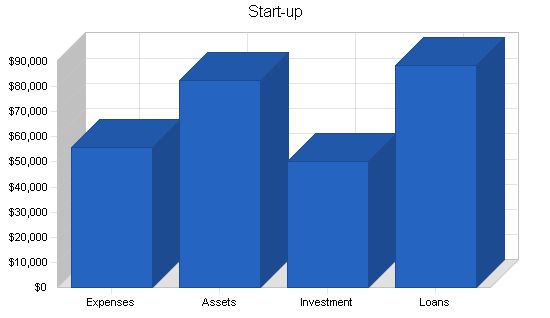
Start-up Expenses:
– Legal Fees: $7,300
– Insurance: $5,800
– Rent: $2,500
– Computer – Administrative: $4,000
– Marketing and marketing strategy: $6,500
– Architect/Remodeling: $15,000
– Equipment (i.e. toys): $8,000
– Projector & Screen: $1,500
– TVs & video game consoles: $1,250
– Computers – Learning: $2,000
– Cleaning supplies: $900
– Office Supplies: $1,000
– Total Start-up Expenses: $55,750
Start-up Assets:
– Cash Required: $65,000
– Start-up Inventory: $1,000
– Other Current Assets: $2,500
– Long-term Assets: $14,000
– Total Assets: $82,500
Total Requirements: $138,250
2.2 Company Ownership:
Play Time for Kids is a privately-held S corporation co-owned by Carry Tayker and Wanda Magic. To achieve our objectives, Play Time for Kids seeks financial backing. The loans will be repaid from the cash flow of the business, secured by the assets of the company, and backed by the character, experience, and personal guarantees of the owners.
Products and Services:
The company sets itself apart from other child entertainment facilities that may offer only one or two types of services. Parents desire these services and are frustrated because they must go to several different businesses or travel long distances. The focus of the company is Play Care and Party Place. The services provided will be exemplary.
The business atmosphere will be clean, friendly, and upscale where customers will be comfortable leaving their children. We will offer fun innovative learning through play and a memorable hassle-free Birthday party.
The business will offer event photos of children’s birthday parties (taken by a professional photographer), a unique concept in this industry. The parent will receive a CD at the end of the party.
Play Time for Kids offers:
– Movie Theatre
– Large playscape
– Playhouse area
– Staff-led Group activities
– Theme Nights
– Art and crafts
– Karaoke stage
– Computer Games
– Playstation 2, XBox, GameCube
– Separate Toddler area
– Educational toys and manipulatives
– Birthday parties
Play Care Rates (Drop-in):
– $7.50 per Hour – One Child (Over 18 Months and potty trained)
– $4.00 per Hour – Each Additional Sibling
Membership:
– $30 Annual Family Registration
Birthday Party A = $200
– 45 minutes in themed party room
– Generic colored paper products
– 100% fruit juice
– Party attendant
– Birthday cake (flavor of choice)
– Balloons
– Gift Cart
– Goodie bags
Birthday Party B = $285
– 45 minutes in themed party room
– Generic colored paper products
– 100% fruit juice
– Party attendant (dressed in customer’s party theme)
– Birthday cake (flavor of choice, and party theme)
– Balloons
– Gift Cart
– Goodie bags
– Play Time for Kids T-shirt for the birthday child
– Reserved parking spot for the birthday child’s parents
– Event pictures (taken by professional photographer) received on CD
– Buy One, Get One Free coupon for each party guest to return with a friend
Family Savings Plan Parents may pre-pay for a discount:
– $110 = $100 (10% DISCOUNT)
– $230 = $200 (15% DISCOUNT)
– $360 = $300 (20% DISCOUNT)
Refer a friend who has never been to Play Time for Kids and receive $5 OFF the price of a new membership.
Market Analysis Summary:
Research indicates that the prime market for an FEC is near urban neighborhoods comprised of middle- to upper-income families. These families search for ways to engage their children that are more than just activities their children passively enjoy. As Howard Gardner writes in his book, "The Unschooled Mind": “As institutions, schools have become increasingly anachronistic, while museums have retained the potential to engage students, to teach them, to stimulate their understanding, and, most important, to help them assume responsibility for their own future learning.” This is the idea behind an edutainment facility. Its purpose is to stimulate children so that they can transition from being taught or entertained (passive) to learning through play (active).
4.1 Market Segmentation:
The U.S. Census Bureau 2000 and the Our County website provide the following demographic information about NorthEast Our County and the areas surrounding it.
– City: Population – 45,874, Income – $72,860, Children under 12 – 27.24%, Households with children – 8,037
– City: Population – 23,290, Income – $62,636, Children under 12 – 22.96%, Households with children – 3,694
– City A: Population – 21,571, Income – $36,799, Children under 12 – 23.56%, Households with children – 2,868
– City A: Population – 31,094, Income – $40,648, Children under 12 – 21.64%, Households with children – 4,282
– Town B: Population – 3,393, Income – $79,402, Children under 12 – 24.97%, Households with children – 566
– Town C: Population – 31,168, Income – $89,644, Children under 12 – 27.60%, Households with children – 5,467
– North Big City Hills: Population – 59,591, Income – $63,968, Children under 12 – 22.02%, Households with children – 9,033
– City D: Population – 7,889, Income – $65,056, Children under 12 – 26.80%, Households with children – 1,349
– City E: Population – 25,834, Income – $63,411, Children under 12 – 25.81%, Households with children – 4,417
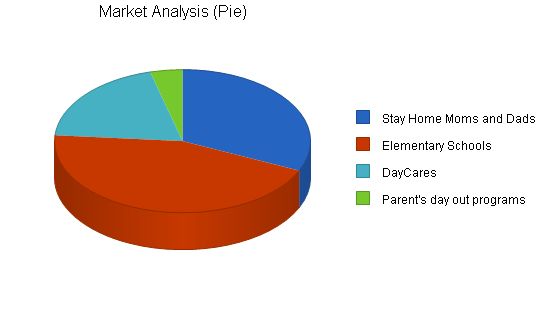
Market Analysis
Year 1 Year 2 Year 3 Year 4 Year 5 CAGR
Potential Customers Growth %
Stay Home Moms and Dads 50% 8,000 12,000 18,000 27,000 40,500 50.00%
Elementary Schools 50% 11,200 16,800 25,200 37,800 56,700 50.00%
DayCares 35% 4,935 6,662 8,994 12,142 16,392 35.00%
Parent’s day out programs 10% 1,020 1,122 1,234 1,357 1,493 9.99%
Total 46.25% 25,155 36,584 53,428 78,299 115,085 46.25%
4.2 Target Market Segment Strategy
Our success relies on becoming known within the community. We must focus on the market segments that match our offerings. Focusing on targeted segments is key to our future. Therefore, the focus and marketing message will be the services offered. Once the message is developed, it will be communicated and fulfilled.
Stay at Home Moms and Dads
Stay-at-home Moms and Dads are an attractive segment. Parents want a place for their children to play and learn. They live in middle-class suburbs near the metropolitan area. The market segment customers lead a lifestyle where children play a large part. The company focuses on meeting the local community need for child play care and birthday party services within a 10-mile radius of Big City. The program allows children to be dropped off or play with their parents.
Elementary Schools
The company aims to establish a relationship with local elementary schools for possible field trips. The strategy for this market is to provide communications through the PTA channels due to past service to the PTA. This approach will provide credibility and communication frequency to our target market. Sufficient flexibility is important to handle this secondary market and generate supplemental revenues.
Day Cares
Local Day Care centers can choose Play Time for Kids as a field trip destination that combines playtime with learning interactions. While this revenue is not the primary focus, it could increase our revenue base by building strong community relations.
Weekend Working Couples
This segment includes weekend working couples in need of child care. This service allows part-time weekend workers and fitness center enthusiasts to drop their children off for several hours. While this market is not a primary focus, sufficient flexibility is important to the local “word-of-mouth” marketing strategy.
4.3 Service Business Analysis
Success is based on becoming known within the community. Play Time for Kids must focus on market segments whose needs match its offerings. Focusing on targeted segments is key to the company’s future. Therefore, marketing messages will focus on the services offered. We will develop our message, communicate it, and fulfill our commitment to excellence.
Play Time for Kids is part of the Recreation Center industry, offering a higher level of direct child care than most other recreation centers. We straddle the line between family entertainment center and daycare facility. We require employees with child care credentials to satisfy safety-conscious parents and programs with “fun” value to attract repeat customers.
4.3.1 Competition and Buying Patterns
Price, service, certification, and reputation are critical success factors in the edutainment/play care services industry. The company will compete well by offering competitive prices, high-quality play care services, leading-edge educational toys, certified, college-educated instructors, and an excellent reputation.
Competition for Play Time for Kids comes from Chuck E. Cheese, McDonald’s, and Clubhouse for Kids, which offer similar services within a 10-mile radius. However, Play Time for Kids differentiates itself by offering an interactive environment that allows children to learn through play.
Large Chain Children’s Entertainment Venues
Competition in the defined geographic area includes Chuck E. Cheese and McDonald’s, which offer entertainment value but little educational value. Play Time for Kids differentiates itself by offering an interactive environment that allows children to learn through play.
Small, Independently Owned Child Play Care Venues
Competition in our area includes Club House for Kids, which offers some learning through play experiences, but lacks direction in activities. Play Time for Kids differentiates itself by offering structured child development activities and play groups guided by Play Time for Kids employees.
Children’s Museums
At one time, Imagisphere Children’s Museum operated nearby. However, they did not have the variety of options Play Time for Kids plans to offer, resulting in a lack of repeat business. Play Time for Kids differentiates itself by offering a variety of options and enhanced entertainment value, leading to increased repeat and referral business.
Strategy and Implementation Summary
The company will succeed by offering children a safe and secure care environment with close personal attention. The goals of the center are to help parents feel good about their children’s care and provide a safe, educational, and fun experience for the child.
5.1 Competitive Edge
Play Time for Kids’ services will provide customers with a premium amusement and edutainment experience by charging a competitive price, obtaining all necessary licensing and certifications, conducting thorough background screenings on employees, and offering innovative, unique birthday parties.
5.2 Marketing Strategy
The company’s marketing strategy focuses on establishing the brand and promoting the image through various channels, including logo and identity development, partnership programs, brochures, flyers, advertising in publications catering to the target market, public relations efforts, direct mail, website promotion, and email marketing. Special events will also be held to increase visibility in the community.
5.3 Sales Strategy
The company expects to gain revenue through word-of-mouth advertising and plans to double its clientele every 6 months during the first 18 months of business. Play Time for Kids will be introduced to the market through targeted advertising, direct mail, website optimization, and direct sales. The venue provides families with the ability to enjoy leisure time together or leave their children to explore on their own.
5.3.1 Sales Forecast
The strongest revenue during the first quarter will come from birthday party sales and membership fees. Word-of-mouth and local advertising will then gain market share, with parents using the daily drop-in service, day cares using it for field trips, and monthly holiday-themed parties. Margins are expected to increase in years two and three through greater efficiency and obtaining bulk rates on paper products.
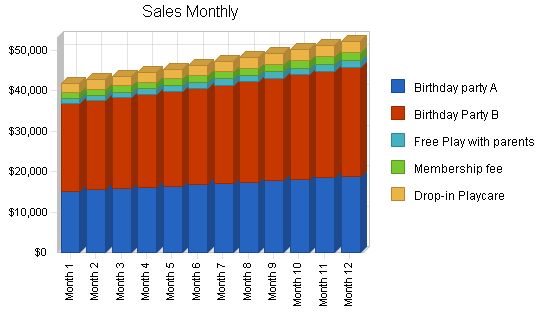
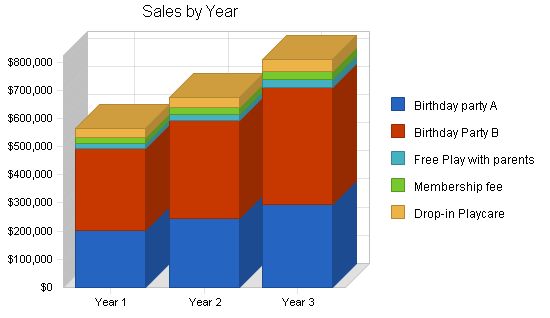
Review:
Sales Forecast:
Contents
Sales Forecast
Sales Year 1 Year 2 Year 3
Birthday party A $203,864 $244,637 $293,564
Birthday Party B $289,701 $347,641 $417,169
Free Play with parents $18,240 $21,888 $26,266
Membership fee $21,288 $25,546 $30,655
Drop-in Playcare $30,177 $36,212 $43,455
Total Sales $563,271 $675,924 $811,109
Direct Cost of Sales Year 1 Year 2 Year 3
Birthday Paper Products $49,356 $53,305 $63,966
Birthday foods and beverages $34,550 $35,537 $35,537
Media Rental for Parties (movies, karaoke) $64,163 $76,996 $92,395
CDs for Parties $240 $320 $366
Costume Rentals $2,468 $2,961 $3,554
Cakes $24,678 $35,607 $42,728
Subtotal Direct Cost of Sales $175,456 $204,726 $238,546
Web Plan Summary:
Web Plan Summary
The Play Time for Kids website will serve as the virtual brochure and online "home" for the company. It will showcase the company’s value proposition, reinforce the qualifications and experience of the organization and staff, and provide a comprehensive overview of services. The site may also offer online parent resources and a community calendar.
The website strategy will combine a well-designed front-end with a back-end for collecting contact information for continued communication with interested parties.
6.1 Website Marketing Strategy
The Play Time for Kids website address will be used on all corporate and promotional materials. The website will support the newly developed messages and feature "active" content to bring visitors back as an information resource. This activity will be supported by newsletters, promotional events, and public relations efforts.
6.2 Development Requirements
The Play Time for Kids website will initially be developed by a professional marketing agency that provides creative design and technical resources. ABC Communications will create and maintain the website, and DEF Hosting will handle the technical back-end. The website’s logos and graphics will be consistent with printed promotional materials.
Management Summary:
Management Summary
Carry Tayker and Wanda Magic have extensive experience in managing Child Care and Family Entertainment Centers, respectively. Their resumes detail their experience in the Big City area.
7.1 Personnel Plan
The Personnel Plan shows that the company expects to gradually invest in personnel over the next three years, considering the number of children in need of care. In addition to the owners, one full-time manager and six full-time care workers will be needed.
Personnel Plan:
Personnel Year 1 Year 2 Year 3
Carry Tayker $13,008 $20,000 $35,000
Wanda Magic $14,070 $20,000 $35,000
Manager $38,000 $40,000 $43,000
Full-time child-care workers $158,400 $162,000 $165,000
Part-time child-care workers $48,000 $50,000 $50,000
Future child-care employees $0 $40,000 $60,000
Total People 13 15 17
Total Payroll $271,478 $332,000 $388,000
Financial Plan
The company’s financial plan is based on conservative estimates and assumptions. The start-up requirements and business sustainability will be funded through a combination of owner investment and loans. The break-even point is expected within 8 months to a year.
8.1 Start-up Funding
Total start-up expenses and required assets will be funded as shown in the Start-up Funding table. The $50,000 of Current Borrowing will be repaid within 3 years, and long-term liabilities will be repaid within 6 years.
Start-up Funding:
Start-up Expenses to Fund $55,750
Start-up Assets to Fund $82,500
Total Funding Required $138,250
Assets:
Non-cash Assets from Start-up $17,500
Cash Requirements from Start-up $65,000
Additional Cash Raised $0
Cash Balance on Starting Date $65,000
Total Assets $82,500
Liabilities and Capital:
Liabilities:
Current Borrowing $50,000
Long-term Liabilities $38,250
Accounts Payable (Outstanding Bills) $0
Other Current Liabilities (interest-free) $0
Total Liabilities $88,250
Capital:
Planned Investment:
Angela Redmon $15,000
BeJe Denson $35,000
Additional Investment Requirement $0
Total Planned Investment $50,000
Loss at Start-up (Start-up Expenses) ($55,750)
Total Capital ($5,750)
Total Capital and Liabilities $82,500
Total Funding $138,250
8.2 Important Assumptions
- The company assumes steady growth from good management.
- The company assumes adequate loans to sustain it during start-up.
General Assumptions:
Year 1 Year 2 Year 3
Plan Month 1 2 3
Current Interest Rate 10.00% 10.00% 10.00%
Long-term Interest Rate 10.00% 10.00% 10.00%
Tax Rate 30.00% 30.00% 30.00%
Other 0 0 0
8.3 Break-even Analysis
The Break-even Analysis is based on the average of the first-year figures for total sales by units and operating expenses. These are presented as per-unit revenue, per-unit cost, and fixed costs. With these projections, the break-even point is expected to be reached in September of the first year.
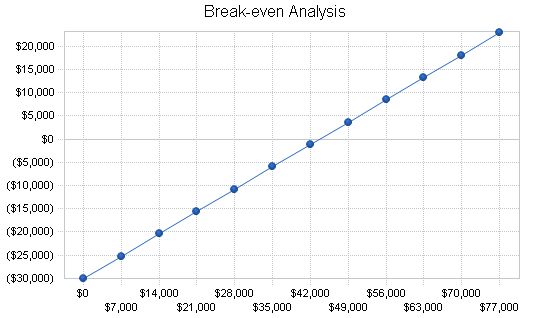
Break-even Analysis:
Monthly Revenue Break-even: $43,645
8.4 Business Ratios:
The table below outlines important ratios from the Recreation Center industry (also known as Family Entertainment Centers). The final column, Industry Profile, details specific ratios based on the industry’s Standard Industry Classification (SIC) code, 7999.9910.
Ratio Analysis:
Year 1 Year 2 Year 3 Industry Profile
Sales Growth 0.00% 20.00% 20.00% 2.76%
Percent of Total Assets
Inventory 0.00% 0.00% 0.00% 3.27%
Other Current Assets 2.95% 3.41% 2.72% 30.63%
Total Current Assets 83.62% 81.32% 85.42% 38.44%
Long-term Assets 16.38% 18.68% 14.58% 61.56%
Total Assets 100.00% 100.00% 100.00% 100.00%
Current Liabilities 53.53% 41.45% 17.13% 26.66%
Long-term Liabilities 37.54% 34.74% 20.77% 24.71%
Total Liabilities 91.07% 76.18% 37.90% 51.37%
Net Worth 8.93% 23.82% 62.10% 48.63%
Percent of Sales
Sales 100.00% 100.00% 100.00% 100.00%
Gross Margin 68.74% 69.61% 70.49% 100.00%
Selling, General & Administrative Expenses 66.38% 68.14% 65.61% 74.21%
Advertising Expenses 0.02% 0.00% 0.00% 2.76%
Profit Before Interest and Taxes 4.73% 2.88% 7.36% 2.23%
Main Ratios
Current 1.56 1.96 4.99 0.96
Quick 1.56 1.96 4.99 0.65
Total Debt to Total Assets 91.07% 76.18% 37.90% 64.43%
Pre-tax Return on Net Worth 251.25% 80.88% 99.14% 3.01%
Pre-tax Return on Assets 22.43% 19.26% 61.57% 8.47%
Additional Ratios:
Year 1 Year 2 Year 3
Net Profit Margin 2.37% 1.46% 4.88%
Return on Equity 175.87% 56.62% 69.40%
Activity Ratios:
Inventory Turnover 0.00 0.00 0.00
Accounts Payable Turnover 22.94 24.33 24.33
Payment Days 13 14 14
Total Asset Turnover 6.64 9.21 8.82
Debt Ratios:
Debt to Net Worth 10.20 3.20 0.61
Current Liab. to Liab. 0.59 0.54 0.45
Liquidity Ratios:
Net Working Capital $25,543 $29,249 $62,784
Interest Coverage 3.51 3.63 19.48
Additional Ratios:
Assets to Sales 0.15 0.11 0.11
Current Debt/Total Assets 54% 41% 17%
Acid Test 1.56 1.96 4.99
Sales/Net Worth 74.33 38.69 14.21
Dividend Payout 0.00 0.00 0.00
Projected Profit and Loss:
The company expects steady growth in profitability over the next three years of operations. Although the last three months of 2006 will generate a net profit, it may not be high enough to counteract outflows in the first three quarters. However, the second and third years, even with additional employees, should generate increasing profits.
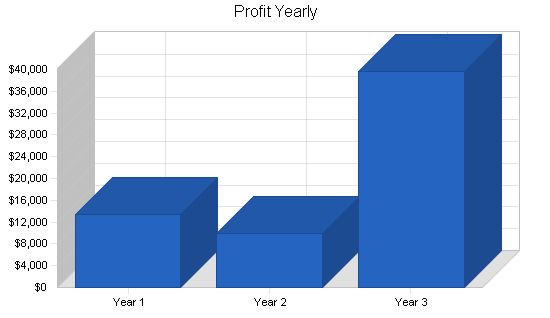
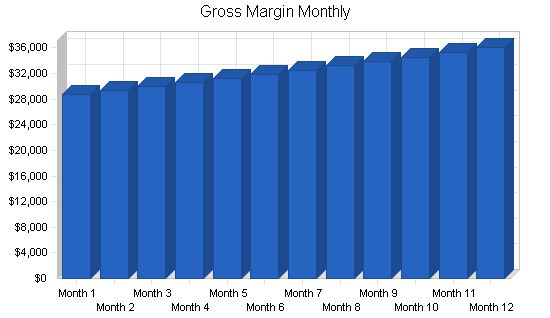
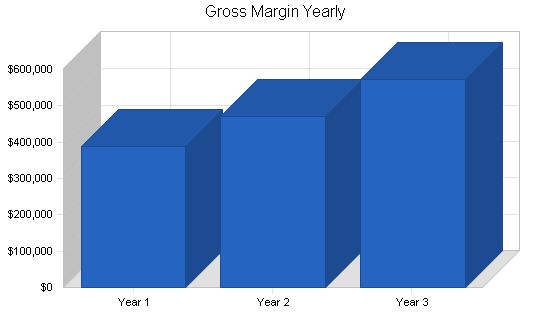
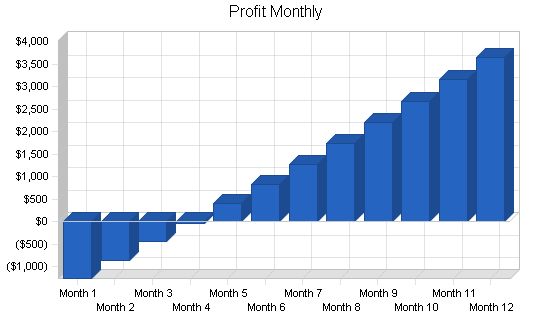
Pro Forma Profit and Loss
| Pro Forma Profit and Loss | |||
| Year 1 | Year 2 | Year 3 | |
| Sales | $563,271 | $675,924 | $811,109 |
| Direct Cost of Sales | $175,456 | $204,726 | $238,546 |
| Other Costs of Sales | $600 | $700 | $800 |
| Total Cost of Sales | $176,056 | $205,426 | $239,346 |
| Gross Margin | $387,215 | $470,498 | $571,763 |
| Gross Margin % | 68.74% | 69.61% | 70.49% |
| Expenses | |||
| Payroll | $271,478 | $332,000 | $388,000 |
| Marketing/Promotion | $4,000 | $4,000 | $4,000 |
| Depreciation | $100 | $200 | $300 |
| Rent | $60,000 | $60,000 | $60,000 |
| Utilities | $15,219 | $17,000 | $18,000 |
| Insurance | $5,800 | $5,800 | $5,800 |
| Payroll Taxes | $0 | $27,000 | $30,000 |
| Other | $4,000 | $5,000 | $6,000 |
| Total Operating Expenses | $360,597 | $451,000 | $512,100 |
| Profit Before Interest and Taxes | $26,618 | $19,498 | $59,663 |
| EBITDA | $26,718 | $19,698 | $59,963 |
| Interest Expense | $7,577 | $5,369 | $3,063 |
| Taxes Incurred | $5,712 | $4,239 | $16,980 |
| Net Profit | $13,328 | $9,891 | $39,620 |
| Net Profit/Sales | 2.37% | 1.46% | 4.88% |
8.6 Projected Cash Flow
The cash flow projection shows that provisions for ongoing expenses are adequate to meet the needs of the company as the business generates sufficient cash flow to support operations. These cash flow projections depend upon receiving the loans necessary to fund our start-up requirements. The table below shows the anticipated repayment of the loans.
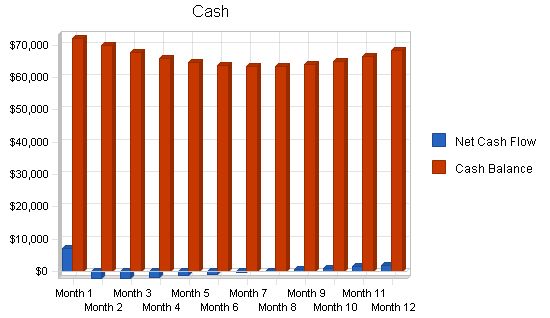
Pro Forma Cash Flow
| Pro Forma Cash Flow | |||
| Year 1 | Year 2 | Year 3 | |
| Cash Received | |||
| Cash from Operations | |||
| Cash Sales | $563,271 | $675,924 | $811,109 |
| Subtotal Cash from Operations | $563,271 | $675,924 | $811,109 |
| Additional Cash Received | |||
| Sales Tax, VAT, HST/GST Received | $0 | $0 | $0 |
| New Current Borrowing | $0 | $0 | $0 |
| New Other Liabilities (interest-free) | $0 | $0 | $0 |
| New Long-term Liabilities | $0 | $0 | $0 |
| Sales of Other Current Assets | $0 | $0 | $0 |
| Sales of Long-term Assets | $0 | $0 | $0 |
| New Investment Received | $0 | $0 | $0 |
| Subtotal Cash Received | $563,271 | $675,924 | $811,109 |
| Expenditures | |||
| Expenditures from Operations | |||
| Cash Spending | $271,478 | $332,000 | $388,000 |
| Bill Payments | $265,272 | $332,206 | $381,161 |
| Subtotal Spent on Operations | $536,750 | $664,206 | $769,161 |
| Additional Cash Spent | |||
| Sales Tax, VAT, HST/GST Paid Out | $0 | $0 | $0 |
| Principal Repayment of Current Borrowing | $16,656 | $16,660 | $16,684 |
| Other Liabilities Principal Repayment | $0 | $0 | $0 |
| Long-term Liabilities Principal Repayment | $6,385 | $6,385 | $6,385 |
| Purchase Other Current Assets | $0 | $0 | $0 |
| Purchase Long-term Assets | $0 | $0 | $0 |
| Dividends | $0 | $0 | $0 |
| Subtotal Cash Spent | $559,791 | $687,251 | $792,230 |
| Net Cash Flow | $3,479 | ($11,327) | $18,879 |
| Cash Balance | $68,479 | $57,152 | $76,032 |
8.7 Projected Balance Sheet
Our projected balance sheet is presented below. Although we do not become fully profitable until year two, we expect a steady increase in net worth.
Pro Forma Balance Sheet
| Pro Forma Balance Sheet | |||
| Year 1 | Year 2 | Year 3 | |
| Assets | |||
| Current Assets | |||
| Cash | $68,479 | $57,152 | $76,032 |
| Inventory | $0 | $0 | $0 |
| Other Current Assets | $2,500 | $2,500 | $2,500 |
| Total Current Assets | $70,979 | $59,652 | $78,532 |
| Long-term Assets | |||
| Long-term Assets | $14,000 | $14,000 | $14,000 |
| Accumulated Depreciation | $100 | $300 | $600 |
| Total Long-term Assets | $13,900 | $13,700 | $13,400 |
| Total Assets | $84,879 | $73,352 | $91,932 |
| Liabilities and Capital | Year 1 | Year 2 | Year 3 |
| Current Liabilities | |||
| Accounts Payable | $12,092 | $13,719 | $15,747 |
| Current Borrowing | $33,344 | $16,684 | $0 |
| Other Current Liabilities | $0 | $0 | $0 |
| Subtotal Current Liabilities | $45,436 | $30,403 | $15,747 |
| Long-term Liabilities | $31,865 | $25,480 | $19,095 |
| Total Liabilities | $77,301 | $55,883 | $34,842 |
| Paid-in Capital | $50,000 | $50,000 | $50,000 |
| Retained Earnings | ($55,750) | ($42,422) | ($32,531) |
| Earnings | $13,328 | $9,891 | $39,620 |
| Total Capital | $7,578 | $17,469 | $57,089 |
| Total Liabilities and Capital | $84,879 | $73,352 | $91,932 |
| Net Worth | $7,578 | $17,469 | $57,089 |
Appendix
Sales Forecast
| Sales Forecast | |||||||||||||
| Month 1 | Month 2 | Month 3 | Month 4 | Month 5 | Month 6 | Month 7 | Month 8 | Month 9 | Month 10 | Month 11 | Month 12 | ||
| Sales | |||||||||||||
| Birthday party A | $0 | $15,200 | $15,504 | $15,814 | $16,130 | $16,453 | $16,782 | $17,118 | $17,460 | $17,809 | $18,165 | $18,529 | $18,899 |
| Birthday Party B | $0 | $21,600 | $22,032 | $22,473 | $22,922 | $23,381 | $23,848 | $24,325 | $24,812 | $25,308 | $25,814 | $26,330 | $26,857 |
| Free Play with parents | $0 | $1,360 | $1,387 | $1,415 | $1,443 | $1,472 | $1,502 | $1,532 | $1,562 | $1,593 | $1,625 | $1,658 | $1,691 |
| Membership fee | $0 | $1,500 | $1,545 | $1,591 | $1,639 | $1,688 | $1,739 | $1,791 | $1,845 | $1,900 | $1,957 | $2,016 | $2,076 |
| Drop-in Playcare | $0 | $2,250 | $2,295 | $2,341 | $2,388 | $2,435 | $2,484 | $2,534 | $2,585 | $2,636 | $2,689 | $2,743 | $2,798 |
| Total Sales | $41,910 | $42,763 | $43,634 | $44,523 | $45,429 | $46,355 | $47,299 | $48,263 | $49,247 | $50,251 | $51,275 | $52,321 | |
| Direct Cost of Sales | Month 1 | Month 2 | Month 3 | Month 4 | Month 5 | Month 6 | Month 7 | Month 8 | Month 9 | Month 10 | Month 11 | Month 12 | |
| Birthday Paper Products | 10% | $3,680 | $3,754 | $3,829 | $3,905 | $3,983 | $4,063 | $4,144 | $4,227 | $4,312 | $4,398 | $4,486 | $4,576 |
| Birthday foods and beverages | 7% | $2,576 | $2,628 | $2,680 | $2,734 | $2,788 | $2,844 | $2,901 | $2,959 | $3,018 | $3,079 | $3,140 | $3,203 |
| Media Rental for Parties (movies, karaoke) | 13% | $4,784 | $4,880 | $4,977 | $5,077 | $5,178 | $5,282 | $5,388 | $5,495 | $5,605 | $
Pro Forma Profit and Loss Sales: $41,910, $42,763, $43,634, $44,523, $45,429, $46,355, $47,299, $48,263, $49,247, $50,251, $51,275, $52,321 Direct Cost of Sales: $13,084, $13,345, $13,612, $13,884, $14,161, $14,444, $14,732, $15,026, $15,327, $15,633, $15,945, $16,263 Other Costs of Sales: $50 Total Cost of Sales: $13,134, $13,395, $13,662, $13,934, $14,211, $14,494, $14,782, $15,076, $15,377, $15,683, $15,995, $16,313 Gross Margin: $28,776, $29,368, $29,972, $30,589, $31,218, $31,861, $32,517, $33,187, $33,870, $34,568, $35,280, $36,008 Gross Margin %: 68.66%, 68.68%, 68.69%, 68.70%, 68.72%, 68.73%, 68.75%, 68.76%, 68.78%, 68.79%, 68.81%, 68.82% Expenses Payroll: $22,502, $22,523, $22,545, $22,566, $22,588, $22,611, $22,633, $22,656, $22,679, $22,702, $22,725, $22,749 Marketing/Promotion: $333 Depreciation: $8 Rent: $5,000 Utilities: $1,200, $1,212, $1,224, $1,236, $1,249, $1,261, $1,274, $1,287, $1,299, $1,312, $1,326, $1,339 Insurance: $483 Payroll Taxes: 15%, $0, $0, $0, $0, $0, $0, $0, $0, $0, $0, $0, $0 Other: $333 Total Operating Expenses: $29,860, $29,893, $29,927, $29,961, $29,996, $30,030, $30,065, $30,101, $30,136, $30,173, $30,209, $30,246 Profit Before Interest and Taxes: ($1,084), ($526), $45, $628, $1,223, $1,831, $2,452, $3,086, $3,734, $4,396, $5,071, $5,762 EBITDA: ($1,076), ($517), $53, $636, $1,231, $1,839, $2,460, $3,094, $3,742, $4,404, $5,080, $5,770 Interest Expense: $719, $703, $687, $671, $655, $639, $623, $607, $591, $575, $559, $543 Taxes Incurred: ($541), ($369), ($193), ($13), $170, $357, $549, $744, $943, $1,146, $1,354, $1,566 Net Profit: ($1,262), ($860), ($450), ($31), $397, $834, $1,280, $1,735, $2,200, $2,674, $3,158, $3,653 Net Profit/Sales: -3.01%, -2.01%, -1.03%, -0.07%, 0.87%, 1.80%, 2.71%, 3.60%, 4.47%, 5.32%, 6.16%, 6.98% Pro Forma Cash Flow Cash Received Cash from Operations: $41,910, $42,763, $43,634, $44,523, $45,429, $46,355, $47,299, $48,263, $49,247, $50,251, $51,275, $52,321 Subtotal Cash from Operations: $41,910, $42,763, $43,634, $44,523, $45,429, $46,355, $47,299, $48,263, $49,247, $50,251, $51,275, $52,321 Additional Cash Received Sales Tax, VAT, HST/GST Received: $0 New Current Borrowing: $0 New Other Liabilities (interest-free): $0 New Long-term Liabilities: $0 Sales of Other Current Assets: $0 Sales of Long-term Assets: $0 New Investment Received: $0 Subtotal Cash Received: $41,910, $42,763, $43,634, $44,523, $45,429, $46,355, $47,299, $48,263, $49,247, $50,251, $51,275, $52,321 Expenditures Expenditures from Operations Cash Spending: $22,502, $22,523, $22,545, $22,566, $22,588, $22,611, $22,633, $22,656, $22,679, $22,702, $22,725, $22,749 Bill Payments: $10,487, $20,425, $21,326, $21,769, $22,222, $22,684, $23,156, $23,637, $24,129, $24,630, $25,142, $25,665 Subtotal Spent on Operations: $32,988, $42,948, $43,871, $44,336, $44,810, $45,295, $45,789, $46,293, $46,807, $47,332, $47,867, $48,414 Additional Cash Spent Sales Tax, VAT, HST/GST Paid Out: $0 Principal Repayment of Current Borrowing: $1,388, $1,388, $1,388, $1,388, $1,388, $1,388, $1,388, $1,388, $1,388, $1,388, $1,388, $1,388 Other Liabilities Principal Repayment: $0 Long-term Liabilities Principal Repayment: $532, $532, $532, $532, $532, $532, $532, $532, $532, $532, $532, $533 Purchase Other Current Assets: $0 Purchase Long-term Assets: $0 Dividends: $0 Subtotal Cash Spent: $34,908, $44,868, $45,791, $46,256, $46,730, $47,215, $47,709, $48,213, $48,727, $49,252, $49,787, $50,335 Net Cash Flow: $7,002, ($2,105), ($2,157), ($1,733), ($1,301), ($860), ($410), $50, $520, $999, $1,488, $1,986 Cash Balance: $72,002, $69,897, $67,740, $66,007, $64,706, $63,846, $63,436, $63,486, $64,006, $65,005, $66,493, $68,479 |
||
Hello!
I’m Andrew Brooks, a seasoned finance consultant from the USA and the mind behind phonenumber247.com.
My career is built on a foundation of helping individuals and businesses thrive financially in an ever-changing economic landscape. At phonenumber247.com, my aim is to demystify the complex world of finance, providing clear, actionable advice that can help you navigate your financial journey with confidence. Whether it’s personal finance management, investment strategies, or understanding the nuances of market dynamics, I’m here to share insights and tools that can propel you towards your financial goals.
Welcome to my digital space, where every piece of advice is a step closer to financial clarity and success!
